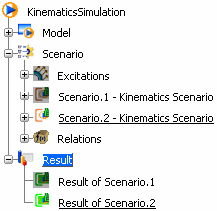Click Simulate and Generate Results  . .
The Simulate and Generate Results dialog box appears. By default, the current scenario is selected.
If you want to simulate another scenario, select the desired scenario in the specification tree.
If you want to compute all the scenarios at once, click  . .
Click OK.
A dialog box appears showing the progress of the simulation and the mechanism is animated.
When the simulation is complete:
- If an error is detected during the computation, the Incident Diagnosis dialog box appears to let you understand, analyze, and solve the problem. The diagnosis appears in the specification tree under Results of Scenario and is stored with the simulation when you propagate the simulation. If you close the Incident Diagnosis dialog box, you can click Incident Diagnosis to open it again, or you can double-click the diagnosis in the specification tree. See Diagnosing Computation Incidents.
- All the specifications defined under the Scenario category are updated.
- The application automatically switches to the Kinematics Postprocessing workbench.
- If you simulate and generate results for the first time, Result appears in the specification tree, and a Result of Scenario node is created for each simulated scenario. For example:

- If the results are already generated, the content of the Result category is updated.
For information about reviewing simulation results, see Viewing the Kinematics Simulation Results. Note:
Generating simulation results does not change the nominal position of a mechanism. To change the nominal position, you must preview the simulation results using the Preview button. For more information, see Setting a Mechanism's Nominal Position.
|